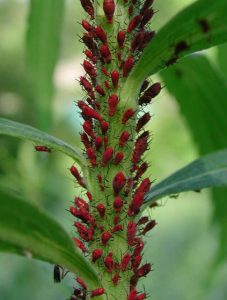 Aphids are soft bodied pear-shaped insects generally less than 1/8 inch long and usually green in color but many are black, brown, pink, yellow, blue, or white. Most aphids are wingless but when colonies become overcrowded or the host plant becomes undesirable, winged forms are produced which establish new colonies.
Aphids are soft bodied pear-shaped insects generally less than 1/8 inch long and usually green in color but many are black, brown, pink, yellow, blue, or white. Most aphids are wingless but when colonies become overcrowded or the host plant becomes undesirable, winged forms are produced which establish new colonies.
Aphids have piercing-sucking mouthparts and cause damage by sucking the plant juices. They are commonly found on the stems, undersides of leaves and on flower buds in colonies of individuals. However, their ability to transmit plant virus diseases may be more harmful than any direct feeding damage.
Aphids seem to be especially troublesome on plants that are in shaded areas. Their feeding causes the leaves to curl or crinkle and flower buds may become hardened causing the flowers to be distorted.
Aphids excrete large amounts of honeydew which is a sugary liquid composed of unused plant sap and waste products. This provides an excellent medium for the growth of a black fungus called sooty mold. Besides being unattractive, sooty mold interferes with photosynthesis and somewhat retards the growth of the plant. Sooty mold usually weathers away following control of the insect infestation. Ants feed on honeydew, therefore when ants are observed, plants should be examined closely for aphids.
What to do?
If the aphid population is high and there are few or no natural enemies present, spray with horticultural oil or try to wash off the aphids with water. Soaps are available that are formulated for controlling insects and related pests. If one of the commercial soaps is unavailable, 3 tablespoons of dishwashing liquid (do not use those containing a degreaser or an automatic dishwashing soap or detergent) per gallon of water may be applied as a foliar spray to woody plants. Use 2 tablespoons for bedding, foliage and flowering plants. Do oil or soap test on a small section of the plant then wait three days to see how the plant reacts. If the plant turns brown then the stop using product, if the plant is green continue applying on a as needed basis. Repeat at weekly intervals as needed. Soap is effective in controlling aphids, safe for people and the environment. Use a garden hose with an adjustable nozzle and spray undersides of leaves and stems when the aphids appear.
 s, praying mantids, assassin bugs, ambush bugs, and aphid lions. Spiders also prey on numerous insect pests. Parasitized aphids have a brown or black colored bloated body. If predators are present or the pests show signs of parasitism, every effort should be made to preserve the beneficial insects. Delay applying a pesticide until damage appears, and provide the beneficials an opportunity to control the pest populations.
s, praying mantids, assassin bugs, ambush bugs, and aphid lions. Spiders also prey on numerous insect pests. Parasitized aphids have a brown or black colored bloated body. If predators are present or the pests show signs of parasitism, every effort should be made to preserve the beneficial insects. Delay applying a pesticide until damage appears, and provide the beneficials an opportunity to control the pest populations.  0
0
